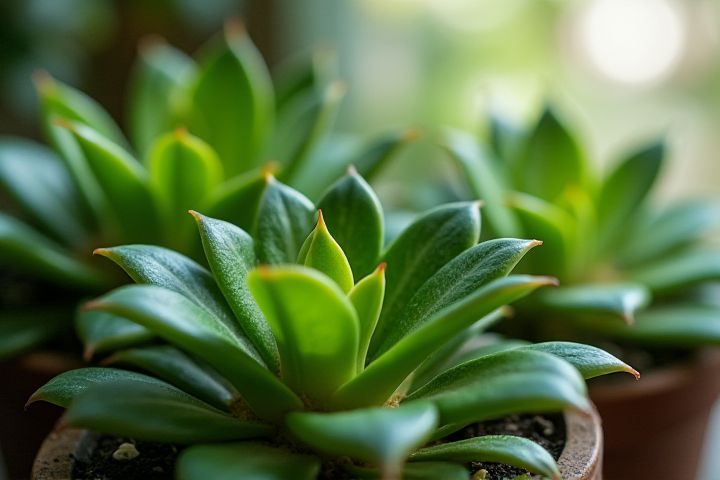
Houseplants often succumb to issues such as overwatering, which leads to root rot, or inadequate lighting that prevents photosynthesis, essential for their growth. Poor soil quality can also hinder nutrient absorption, depriving plants of vital minerals and water retention. Pests like spider mites and aphids can infest and weaken houseplants, causing stress and eventual decline. Temperature fluctuations, especially extreme heat or cold drafts, can shock plants, making them more susceptible to diseases. Regularly monitoring your plant's environment and health can help you identify these problems early, ensuring your houseplants thrive longer.
Why Houseplants Die Easily
Overwatering
Overwatering is the leading cause of houseplant demise, responsible for approximately 50% of plant failures. When soil remains excessively wet, it deprives roots of vital oxygen, leading to root rot and fungal infections. Signs of overwatering include yellowing leaves, wilting, and a sour smell emanating from the soil. To prevent overwatering, ensure pots have drainage holes and allow the top inch of soil to dry out before rewatering.
Poor drainage
Poor drainage can significantly contribute to the decline of houseplants, leading to root rot and other moisture-related issues. When water accumulates in the potting medium, oxygen becomes scarce, inhibiting the roots' ability to absorb nutrients effectively. In fact, around 50% of houseplant deaths can be traced back to overwatering and inadequate drainage systems. To prevent this, consider utilizing pots with drainage holes or incorporating perlite into the soil mixture, ensuring your plants thrive with the right balance of moisture.
Lack of sunlight
Houseplants thrive on adequate sunlight, as it is crucial for their photosynthesis process. Insufficient light can lead to weak growth, stunted leaves, and ultimately, plant death. Specifically, many popular houseplants require bright indirect light for several hours daily; a lack of it can cause symptoms like yellowing leaves and leggy stems. To maintain healthy plants, place them near windows or use artificial grow lights, ensuring they receive the necessary light exposure for vitality.
Low humidity
Low humidity levels, particularly below 30%, can lead to houseplants dying easily due to insufficient moisture in the air. Many tropical plants, which thrive in high humidity, can display symptoms such as wilting, browning leaf tips, and stunted growth when exposed to dry conditions. Your plant's ability to transpire and absorb nutrients diminishes, resulting in poor health and increased vulnerability to pests and diseases. Investing in a humidifier or regularly misting your plants can help maintain optimal humidity levels, ensuring their vitality and longevity.
Pest infestation
Pest infestation is a leading cause of houseplant decline, often manifesting as yellowing leaves, stunted growth, or visible insects. Common pests like aphids, spider mites, and mealybugs thrive in the indoor environment, where they can reproduce rapidly, with some species able to double their population within a week. Regularly inspecting your plants for signs of infestation, such as webbing or sticky residue, can help you catch these issues early. Implementing integrated pest management strategies, which may include using insecticidal soaps or introducing beneficial insects, can significantly improve your plants' health and longevity.
Incorrect temperature
Incorrect temperature is a primary factor contributing to houseplant mortality. Most houseplants thrive in temperatures ranging from 65degF to 75degF (18degC to 24degC), and exposure to temperatures outside this range can lead to stress or damage. Cold drafts or excessive heat from appliances can further exacerbate these issues, causing wilting, yellowing leaves, or root rot. Ensuring your plant is placed in an appropriate environment can significantly enhance its vitality and lifespan.
Poor soil quality
Poor soil quality significantly contributes to the decline of houseplants, as it can lead to insufficient drainage, nutrient deficiency, and compaction. Soil that lacks organic matter fails to retain moisture and nutrients, which are essential for healthy plant growth. Without adequate aeration, roots struggle to absorb water and nutrients, making plants more susceptible to diseases and pests. Ensuring your houseplants are potted in high-quality, well-draining soil mix can dramatically enhance their growth and longevity.
Fertilizer burn
Fertilizer burn occurs when plants are exposed to excessive amounts of fertilizer, leading to brown leaf tips, wilting, or even plant death. This condition is caused by high concentrations of salts and nutrients, which can dehydrate plant roots and hinder their ability to absorb water. It's crucial to follow recommended application rates and to dilute fertilizer appropriately to avoid this issue. Regularly checking soil moisture levels and observing your houseplant for signs of distress can help ensure a healthy growing environment.
Root rot
Root rot is a prevalent issue that often leads to the demise of houseplants, affecting over 90% of plant owners at some point. This condition occurs when roots sit in waterlogged soil for too long, typically caused by overwatering or poor drainage, resulting in fungal infections. Signs of root rot include yellowing leaves, wilting, and a foul odor emanating from the soil, making it crucial to act quickly. Ensuring a well-draining pot and monitoring your watering schedule can significantly reduce the risk of root rot and promote a healthier plant environment.
Neglect
Neglect is a primary reason why houseplants often succumb to decline; many plants require consistent care, including regular watering and adequate light exposure. On average, most houseplants need to be watered every 1 to 2 weeks, depending on the species and environmental conditions. Without proper attention, you may inadvertently overlook essential growth factors, such as nutrient-rich soil or humidity levels, which can lead to wilting or leaf drop. Understanding the specific needs of your houseplants can significantly enhance their longevity and vibrancy.
